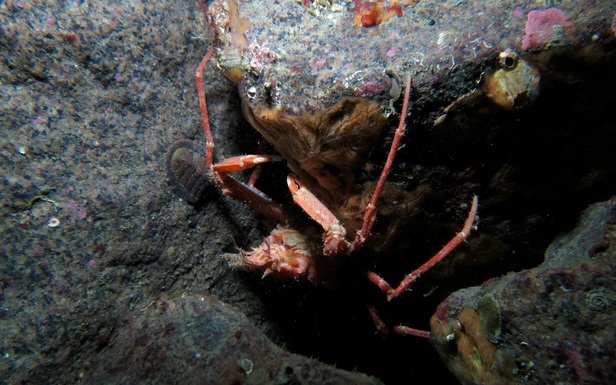Longhorn decorator crab, decorator crab • Chorilia longipes
Identification
This decorator crab has a spiny, pear-shaped carapace that reaches 4.5 cm wide. Its rostrum is composed of two long divergent horns, and it has long, slender, and fairly smooth walking legs. It is often undecorated, or is decorated with bryozoans or sponges. Underneath its decorations this crab is a pinkish-orange colour, and often has white bands on its legs. See the E-Fauna and Rosario Beach Marine Laboratory species pages for more identification information.
Habitat & Range
This species is found in shallow subtidal habitats (9 m) to a depth of 1190 m (3900 ft.). It is found on rocks when in shallower depths, and on sandy, muddy, or shell-strewn substrates in deeper waters. Its range stretches from Kodiak, Alaska to Mexico.
Similar Species
The longhorn decorator crab can be confused with the more common slender decorator crab. Unlike the longhorn decorator, the slender decorator has curved spines behind its eyestalks, and its long walking legs are covered in hooked setae. It has a relatively smooth, heart or triangle-shaped carapace that is usually very decorated with algae, bryozoans, hydroids, sponges, or other growths. Its rostral horns are parallel rather than divergent. The slender decorator crab is usually much more decorated than the longhorn, which is often undecorated or lightly decorated.
The following video shows the decorating process of a decorator crab:
This decorator crab has a spiny, pear-shaped carapace that reaches 4.5 cm wide. Its rostrum is composed of two long divergent horns, and it has long, slender, and fairly smooth walking legs. It is often undecorated, or is decorated with bryozoans or sponges. Underneath its decorations this crab is a pinkish-orange colour, and often has white bands on its legs. See the E-Fauna and Rosario Beach Marine Laboratory species pages for more identification information.
Habitat & Range
This species is found in shallow subtidal habitats (9 m) to a depth of 1190 m (3900 ft.). It is found on rocks when in shallower depths, and on sandy, muddy, or shell-strewn substrates in deeper waters. Its range stretches from Kodiak, Alaska to Mexico.
Similar Species
The longhorn decorator crab can be confused with the more common slender decorator crab. Unlike the longhorn decorator, the slender decorator has curved spines behind its eyestalks, and its long walking legs are covered in hooked setae. It has a relatively smooth, heart or triangle-shaped carapace that is usually very decorated with algae, bryozoans, hydroids, sponges, or other growths. Its rostral horns are parallel rather than divergent. The slender decorator crab is usually much more decorated than the longhorn, which is often undecorated or lightly decorated.
The following video shows the decorating process of a decorator crab:
References
Cowles, D. (2005). Chorilia longipes Dana, 1851. Invertebrates of the Salish Sea. Rosario Beach Marine Laboratory. Accessed 01/04/2014.
Harbo, R.M. (1999). Whelks to whales: Coastal marine life of the Pacific Northwest. Madeira Park, BC: Harbour Publishing. P. 76.
Hart, J. (1984). Chorilia longipes Dana, 1851. In Klinkenberg, Brian. (Editor) 2012. E-Fauna BC: Electronic Atlas of the Fauna of British Columbia. Lab for Advanced Spatial Analysis, Department of Geography, University of British Columbia, Vancouver. Accessed 01/04/2014.
Jensen, G.C. (1995). Pacific Coast Crabs and Shrimp. Monterey, CA: Sea Challengers. P. 23.
Authors and editors of page
Kelly Fretwell and Brian Starzomski (2014).
Cowles, D. (2005). Chorilia longipes Dana, 1851. Invertebrates of the Salish Sea. Rosario Beach Marine Laboratory. Accessed 01/04/2014.
Harbo, R.M. (1999). Whelks to whales: Coastal marine life of the Pacific Northwest. Madeira Park, BC: Harbour Publishing. P. 76.
Hart, J. (1984). Chorilia longipes Dana, 1851. In Klinkenberg, Brian. (Editor) 2012. E-Fauna BC: Electronic Atlas of the Fauna of British Columbia. Lab for Advanced Spatial Analysis, Department of Geography, University of British Columbia, Vancouver. Accessed 01/04/2014.
Jensen, G.C. (1995). Pacific Coast Crabs and Shrimp. Monterey, CA: Sea Challengers. P. 23.
Authors and editors of page
Kelly Fretwell and Brian Starzomski (2014).




